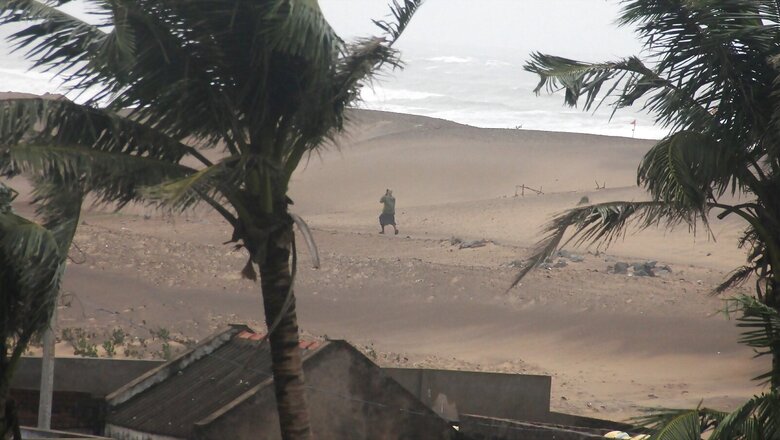
views
A low-pressure area has formed in the Bay of Bengal which is likely to intensify into the first tropical cyclone of the post-monsoon season of 2022 on October 24, the India Meteorological Department (IMD) has said. According to the weather agency, the possible cyclonic storm in the Bay of Bengal will likely reach the West Bengal-Bangladesh coasts by October 25, skirting Odisha.
If the tropical storm intensifies into a cyclone as predicted, it would be called Sitrang, a name suggested by Thailand. Prior to this, the last October cyclone in the Bay of Bengal was Titli in 2018.
Cyclone Sitrang
On Thursday, IMD said that the low-pressure area formed in the Bay of Bengal is very likely to move west-northwestwards and develop into a depression over the east-central and adjoining southeast Bay of Bengal around October 22.
It is likely to intensify into a deep depression by October 23. “Subsequently, it is likely to re-curve northwards and intensify into a cyclonic storm over the west-central and adjoining east-central Bay of Bengal by October 24. Thereafter, it is likely to gradually move north-northeastwards and reach near the West Bengal-Bangladesh coasts by October 25, skirting Odisha,” IMD Director General Mrutunjay Mohapatra said.
The storm is further expected to develop into a severe cyclonic storm later on October 25.
Mohapatra, however, clarified that the IMD has not so far made any forecast on the possible landfall, intensity and wind speed of the cyclone.
“The system will pass through Odisha coast at a distance and there was no possibility of making landfall in the state. Odisha will, however, experience heavy to very heavy rainfall in isolated places from October 23,” he said.
States Which are Likely To Be Affected
IMD has not released any probable track for the cyclone yet, but as per the latest updates, the prevailing low-pressure system is expected to affect India’s east coast in the coming four days, mainly Andaman and Nicobar islands, Odisha and West Bengal, along with neighbouring Bangladesh.
The Met Department said the cyclonic storm is likely to cause widespread light to moderate rainfall in Gangetic West Bengal, with isolated heavy to very heavy downpours on Monday and Tuesday.
Low Pressure Area over North Andaman Sea and adjoining areas & it’s likely intensification into a Cyclonic Storm. pic.twitter.com/CQs7ucfBuy— IMD Kolkata (@ImdKolkata) October 21, 2022
It has forecast heavy rain (7-11 cm) in the coastal districts of East Midnapore, South 24 Parganas and North 24 Parganas on Monday, and heavy to very heavy rainfall (7-20 cm) on Tuesday.
Wind speed can reach 60-70 kmph per hour gusting to 80 kmph over North Bay of Bengal on Monday, and 70-80 kmph gusting to 90 kmph in the area on Tuesday, the weather office said. Fishermen have been advised not to venture into the sea from Sunday until further notice.
States Prepare To Deal With Any Emergency Situation
Bracing for the situation, Odisha and West Bengal have kept their disaster management apparatus ready for any eventuality including heavy to very heavy rainfall in their coastal districts.
Odisha’s Revenue and Disaster Management Minister Pramila Mallick said that instructions have been issued to all the districts and coastal region authorities to deal with any eventuality. The system is likely to trigger heavy rainfall when it crosses parallel to the state’s coast on Monday.
Mallick said personnel of the fire service department, the ODRAF and NDRF are on standby for any emergency situation.
Meanwhile, the West Bengal government has begun the process of evacuating people from low-lying areas in Purba Medinipore, South 24 Parganas and Sundarbans to safe shelters in the wake of the cyclone forecast.
Chief Minister Mamata Banerjee has convened an emergency meeting at state secretariat ‘Nabanna’ on Friday to take stock of the preparedness.
Leaves of all district magistrates, SPs and emergency department workers have been cancelled as a part of the preparedness for the possible cyclone, a senior official said, adding that tarapauline, dry food and medicines have also been adequately stocked in these districts.
The Kolkata Police’s disaster management team has been asked to work in tandem with Kolkata Municipal Corporation officials to address any emergency-like situation, he added.
Red Warning For Fishermen
The IMD has advised fishermen to return to the coast by October 21 as the sea will become rough.
“In anticipation of the formation of a cyclonic storm over Westcentral and adjoining East central Bay of Bengal, fishermen are advised not to venture into the sea from October 23 onwards until further notice. Those who are in the deep sea are advised to return to the coast by October 22 night,” the weather agency said in its bulletin.
The October storm
The North Indian Ocean — comprising the Bay of Bengal and the Arabian Sea often witness storms of severe intensity in the months of October-November and May June. An average of 5 storms develop in the region in a calendar year. According to the Regional Specialised Meteorological Centre (RSMC), 61 storms develop in the Bay of Bengal in the month of October in the last 131 years, including the Super Cyclone of 1999 that hit Odisha.
Explaining the phenomenon, Umasankar Das, Scientist, Meteorological Centre, Bhubaneshwar said that after the withdrawal of the Southwest monsoon, the temperature of the sea surface rises over the Bay of Bengal due to ocean heating.
“The atmospheric moisture availability over the ocean region, too, is higher. So, when remnant systems from the South China Sea reach the Bay of Bengal, they get conducive conditions, aiding the formation and intensification of cyclones in October,”, The Indian Express quoted Das as saying.
However, this phenomenon is not permanent. In some years, ocean-atmospheric factors hinder it, like in 2020, when the weak La Nina conditions along the equatorial Pacific Ocean prevented a cyclonic formation near India’s coasts
Read all the Latest Explainers here



















Comments
0 comment